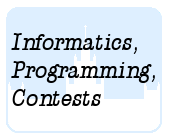 Лето 8
Лето 8
A. URL B. A New Growth Industry C. Раскраска кубиков D. Симпатичные узоры 2 E. Две строки F. Печать G. Гладкие числа
 B. A New Growth Industry
B. A New Growth Industry
 Моделирование
МоделированиеОлимпиадные задачи на английском языке

| 02/07/2007 | Лето 2007 дорешивание ( 8B) |
| 18/07/2007 | Лето 2007 - 8 (B) |
Ограничения: время – 2s/4s, память – 32MiB Ввод: input.txt или стандартный ввод Вывод: output.txt или стандартный вывод 
Послать решение Blockly Посылки Темы Где Обсудить (0)
A biologist experimenting with DNA modification of bacteria has
found a way to make bacterial colonies sensitive tothe
surrounding population density. By changing the DNA, he is able
to "program" the bacteria to respond to the varying densities in
their immediate neighborhood.
The culture dish is a square, divided into 400 smaller squares
(20x20). Population in each small square is measured on a four
point scale (from 0 to 3).The DNA information is represented as an array `D`, indexed
from 0 to 15, of integer values and is interpreted as follows: In any given culture dish square,
let `K` be the sum of that square's density and the
densities of the four squares immediately to the left, right, above and below that square
(squares outside the dish are considered to have density 0). Then, by the next day, that
dish square's density will change by `D[K]` (which may be a positive, negative, or zero
value). The total density cannot, however, exceed 3 nor drop below 0.
Now, clearly, some DNA programs cause all the bacteria to die off (e.g., `[-3,-3,\ …,\ -3]`).
Others result in immediate population explosions (e.g., `[3,3,3,\ …,\ 3]`), and others are just
plain boring (e.g., `[0,\ 0,\ …,\ 0]`). The biologist is interested in how some of the less
obvious DNA programs might behave.
Write a program to simulate the culture growth,reading in the number of days to be
simulated, the DNA rules, and the initial population densities of the dish.
Input to this program consists of three parts:
- The first line will contain a single integer denoting the number of days to be simulated.
- The second line will contain the DNA rule `D` as 16 integer values,ordered from `D[0]` to `D[15]`, separated from one another by one or more blanks. Each integer will be in the range `-3…3`, inclusive.
- The remaining twenty lines of input will describe the initial population density in the culture dish. Each line describes one row of squares in the culture dish, and will contain 20 integers in the range `0…3`, separated from one another by 1 or more blanks.
The program will produce exactly 20 lines of output, describing the population densities
in the culture dish at the end of the simulation. Each line represents a row of squares in
the culture dish, and will consist of 20 characters,plus the usual end-of-line terminator.
Each character will represent the population density at a single dish square, as follows:
| Density | Character |
| 0 | . |
| 1 | ! |
| 2 | X |
| 3 | # |
No other characters may appear in the output.
Sample Input
2 0 1 1 1 2 1 0 -1 -1 -1 -2 -2 -3 -3 -3 -3 3 0 0 0 0 0 0 0 0 0 0 0 0 0 0 0 0 0 0 0 0 0 0 0 0 0 0 0 0 0 0 0 0 0 0 0 0 0 0 0 0 0 0 0 0 0 0 0 0 0 0 0 0 0 0 0 0 0 0 0 0 0 0 0 0 0 0 0 0 0 0 0 0 0 0 0 0 0 0 0 0 0 0 0 0 0 0 0 0 0 0 0 0 0 0 0 0 0 0 0 0 0 0 0 0 0 0 0 0 0 0 0 0 0 0 0 0 0 0 0 0 0 0 0 0 0 0 0 0 0 0 0 0 0 0 0 0 0 0 0 0 0 0 0 0 0 0 0 0 0 0 0 0 0 0 0 0 0 0 0 0 0 0 0 0 0 0 0 0 0 0 0 0 0 0 0 0 0 0 0 0 0 0 0 0 0 0 0 0 3 0 0 0 0 0 0 0 0 0 0 0 0 0 0 0 0 0 0 0 0 0 0 0 0 0 0 0 0 0 0 0 0 0 0 0 0 0 0 0 0 0 0 0 0 0 0 0 0 0 0 0 0 0 0 0 0 0 0 0 0 0 0 0 0 0 0 0 0 0 0 0 0 0 0 0 0 0 0 0 0 0 0 0 0 0 0 0 0 0 0 0 0 0 0 0 0 0 0 0 0 0 0 0 0 0 0 0 0 0 0 0 0 0 0 0 0 0 0 0 0 0 0 0 0 0 0 0 0 0 0 0 0 0 0 0 0 0 0 0 0 0 0 0 0 0 0 0 0 0 0 0 0 0 0 0 0 0 0 0 0 0 0 0 0 0 0 0 0 0 0 0 0 0 0 0 0 0 0 0 0 0 0 0 0 0 0 0 0 0 0 0 0 0 0 0 0 0 0 0 0 0 0 0 0 0 0 0 0 0 0
Sample Output
##!................. #!.................. !................... .................... .................... .................... .................... .........!.......... ........!#!......... .......!#X#!........ ........!#!......... .........!.......... .................... .................... .................... .................... .................... .................... .................... ....................

 Начало
Начало